| کد مقاله | کد نشریه | سال انتشار | مقاله انگلیسی | نسخه تمام متن |
|---|---|---|---|---|
| 5740531 | 1616300 | 2017 | 8 صفحه PDF | دانلود رایگان |

- Quantitative and qualitative assessment of indoor fungal contamination in traditional baths was conducted.
- Aspergillus, Penicillium and Candida were the most frequently isolated genera.
- Fungal loads are significantly related to the average number of customers and mean opening year of the Hammams.
- Hammams were suspected in mycoses transmission considering high level of fungal contamination.
This study was carried out to provide an overview of the fungal load in Algerian traditional baths (Hammams) as well as to isolate and identify the main pathogenic fungi. Over a period of four months, ten baths were examined and screened for fungal contamination from several parts of the hot steamy rooms (floor, wall, door, air and marble massage platform). In total, 7157 fungi isolates were recovered from the surveyed Hammams and the most abundant molds were Penicillium spp. (45.12%) followed by Aspergillus spp. (28.80%). In addition, molds flora in traditional baths was characterized by a large number of hydrophilic species like Cladosporium, Fusarium, Rhizopus, Mucor and Alternaria. Eight candida-like appeared frequently (C. albicans, C. glabrata, C. tropicalis, C. lipolytica, Geotrichum sp., Trichosporon sp., Rhodotorula sp. and Cryptococcus sp.) of which C. albicans was the common isolated yeast (35.14%). The results indicate a significant difference (p = 0.007) in species richness between molds and yeasts and their distribution varied significantly among sampled positions in baths. ANCOVA revealed a significant increase in fungal loads related to the average number of customers and mean opening year of the Hammams, in contrast with locality (favored or popular district). This study indicates that Hammams present a potential source of pathogenic fungi which may impose a real threat on public health.
334
Journal: International Biodeterioration & Biodegradation - Volume 117, February 2017, Pages 115-122